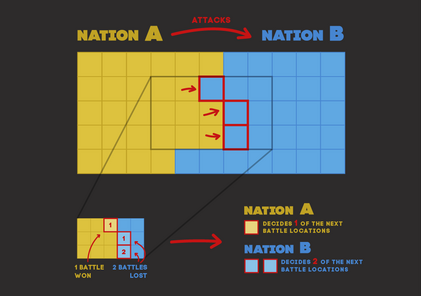War Rules Draft
The war rules are based on concepts of tabletop wargaming, with the intent to create a better strategic experience in wars, rather than a focus on all-or-nothing battles. Wars are focused on tiles, third party oversight, and regulation.
Organizing War
Starting a war
War is declared publicly in #global-news, pinging all nations involved in fighting. Any allies being called in should link back to the initial war declaration when announcing involvement, and ping all nations involved. Excessive declarations, or declarations that can be seen as impossible to fulfill a war over may be rejected by staff. The attacking nation must indicate the location(s) of their initial attacks.
The attacking nation must have basic maps ready for all initial participants when they declare the war. Following the declaration, opposing sides may propose their own map, to be approved by the War Monitor. Allies must create their own maps (at least a draft) before being allowed to fight.
War Monitor
The War Monitor is an appointed role for every war by the staff team of cinder. The job of the War Monitor is to regulate the war both in discord and in game. War Monitor responsibilities include:
- The drawing of tile maps for the war
- Announcing the war schedule
- Regulating participation of players in war and battles
- Setting up the War Organization Chat in the discord
- Deciding the representatives of the sides
- Deciding battle outcomes
The War Monitor should aim to maintain a schedule of 1 battle every 3 days, unless mutually agreed by representatives to postpone/push forward
Representatives
Alliances within a war are limited to 1 representative in the War Organization Chat, that may be replaced by the War Monitor. Representatives are responsible for providing the War Monitor with information to allow them to fairly and accurately make decisions. Representative responsibilities include:
- Providing lists of alliance combatants
- Providing available times
- Providing map information
- Detailing where battles will happen
Representatives may be removed by the War Monitor for toxic behavior in chat, bad sportsmanship, gamesmanship, or stalling.
War Map
The War Map is the visual aid for the war to show who controls what, as decided by the War Monitor using map information from the representatives of the war. The map must be completed before battles can begin. The War Map should be drawn using the basic standards:
- Physical Map showing terrain and builds
- Clear tile and national borders
- Clear identifiers of tile development
- Clear colours to distinguish ownership (differentiating occupation or limited control)
- Clear markings for any defensive structures
- Clear marking for which tiles are being attacked
- Minimizing inclusion of undeveloped land
Once the map is created, national and tile boundaries will remain the same until the conclusion of the war (unless diplomacy to involve another nation dictates a change). Undeclared builds made outside of the defined areas may be announced as unprotected by decision of the War Monitor, and have grief/theft protections lifted.
Tiles
Tiles are the subdivisions of the map showing where battles can take place, and how players can use the locations. Each tile has a descriptor to tell players how they operate
- Underdeveloped: Tiles that contain smaller builds such as villages, outposts, farms, or critical infrastructure. Underdeveloped tiles may be vast in size, but the true battle area is only around the primary builds of the tiles.
- Developed: Tiles containing larger towns, slightly denser construction, or higher effort builds.
- Urban: Urban tiles are densely developed, massive, and/or highly populated by many different players. Urban areas may be subdivided into smaller tiles to allow for partial occupations of cities.
Tiles may have sub descriptors as well
- Occupied: Tiles that have been occupied over the course of the war. Occupied tiles may only receive minor alterations, such as destroying defenses, looting, graffiti, and small builds
- Limited: Tiles that cannot be used due to being acquired or given away during the war through diplomacy. Limited tiles may not be spawned in, and may be freely looted. The War Monitor decides when a tile is no longer limited.
- Uncontrollable: Tiles that are distant, impossible to reach, or are encircled. Only the primary player who has developed it may defend it, and players may not use it to attack out of.
- Mixed: Mixed tiles are tiles that contain a mix of opposing sides builds. Mixed tiles are considered as default part of the first battles to decide ownership, without affecting Initiative.
- Targeted: Targeted tiles are tiles announced as about to be attacked. These tiles cannot be edited in any way.
- Controlled: Controlled tiles are the tiles one side directly owns
Initiative

Initiative is the system to track who gets to decide where battles will take place. The system rewards victory in a tile with the ability to choose where the next battle will be. the aggressor always starts with all 3 points of initiative. Choosing to not use a point of initiative will have it become a defaulted loss.
Attacking
Initiative can be used to attack tiles either adjacent to a controlled tile, or accessible through uncontrolled territory.